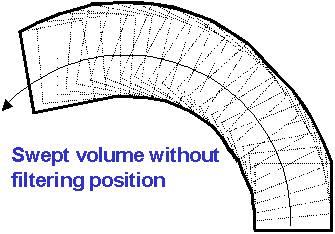Licensing
- Filtering enables you to create a coarser version of a swept volume.
- A relative swept volume computes the swept volume of a moving part in the system axis of another moving part.
About Filtering
Filtering precision
defines the maximum distance allowed between the simplified trajectory and
the initial one
(a.k.a., discretization precision)
- The first illustration shows the original motion.

- The output when Filter Positions is not selected.

- Filter Positions is selected; Filtering precision
= 5mm

- Filter Positions is selected; Filtering precision
= 10mm

About Relative Swept Volume


